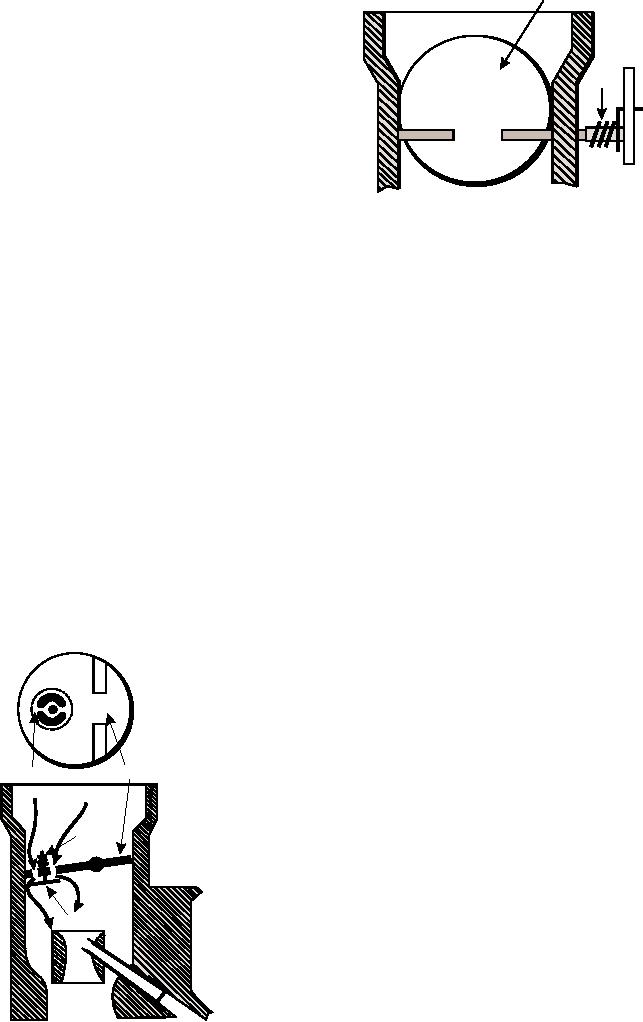
C h o k e Va l v e
Choke Circuit
When the engine is cold, the gasoline vapors tend to
condense into large drops on their way to the cylinders.
Spring
Because all the gasoline supplied to the cylinders will
not vaporize, it becomes necessary to supply a richer
mixture to have enough vapor to assure combustion.
This is accomplished by the choke circuit, which is a
choke valve plate placed in the carburetor throat above
the venturi.
ASf04019
When an operator sets the choke, the choke valve
tilts in the air horn to reduce the amount of air entering
Figure 4-19.--Off-center choke valve.
the throat, giving a very rich mixture. Only the volatile
parts of the gasoline will vaporize at cold temperatures;
overcomes the spring tension and opens the choke valve
therefore, a rich mixture is necessary. It provides
part way, admitting enough air to prevent overchoking
enough ignitable vapor to start the engine. However, if
or flooding the engine. As the engine warms up, the
the choke valve is in the full-choke position, it is
choke valve is gradually advanced to the wide-open
completely closed, shutting off the supply of air.
position by the operator to supply the leaner mixture
Consequently, there is not enough air entering the
required for a hot engine.
throat to allow the gasoline to ignite. The necessary air
In most modern engines, automatic chokes (figs.
is admitted in manual chokes by either one of two
4-20 and 4-21) have replaced the conventional manual
semiautomatic features.
choke. They control the fuel-air ratio for quick starting
In one design, the choke valve incorporates a
at low temperature and also provide for the proper
spring-loaded poppet valve (fig. 4-18). The poppet is
amount of choking to enrich the fuel-air mixture for all
held in the closed position by a weak spring. As soon as
conditions of engine operation during the warm-up
the engine turns over, there is sufficient pressure
period. The automatic choke built into the carburetor in
differential to open the valve, allowing a small amount
figure 4-20 consists of a thermostatic (bimetal) spring
of air to flow.
and a vacuum piston, which opposes the action of the
In the other design, the valve is off-center (fig.
spring. The spring is connected to the choke valve in
4-19) and operated through a coiled spring on the end of
such a manner as to close the valve when the spring is
the choke shaft. In the full-choke position, the spring
cold. The vacuum piston tends to open the choke valve
holds the choke valve in the closed position. As soon as
when the engine manifold vacuum is high. The choke
the engine turns over, an increased pressure differential
valve is mounted off-center on the choke shaft so that
any increase in air velocity through the air horn will
tend to open the valve.
The operation of the automatic choke, shown in
figure 4-20, is dependent on three factors: heat, intake
manifold vacuum, and the velocity of air passing
through the air horn. When the engine is cold, the
thermostatic spring holds the choke valve closed. When
Choke Valve
Poppet Valve
the engine is started, the low pressure (high vacuum)
Air
below the throttle valve permits atmospheric pressure
to move the piston down and partially open the valve
Spring
against the tension of the thermostatic spring. Under
varying load conditions during warm-up, the position
of the choke valve will be changed by the operation of
the vacuum piston working against the thermostatic
Poppet Valve
spring, and the air velocity in the air horn. Hot air from
the exhaust manifold is directed to the thermostatic
spring so that the spring loses its tension as the engine is
heated. This permits the choke to open gradually and,
after it reaches full-open position, it is held open by the
action of the intake manifold on the piston. When the
ASf04018
Figure 4-18.--Spring-loaded poppet valve in choke valve.
4-12

